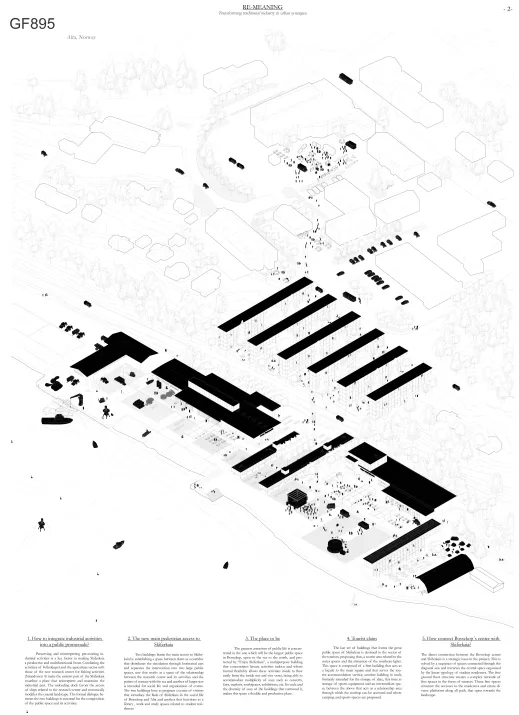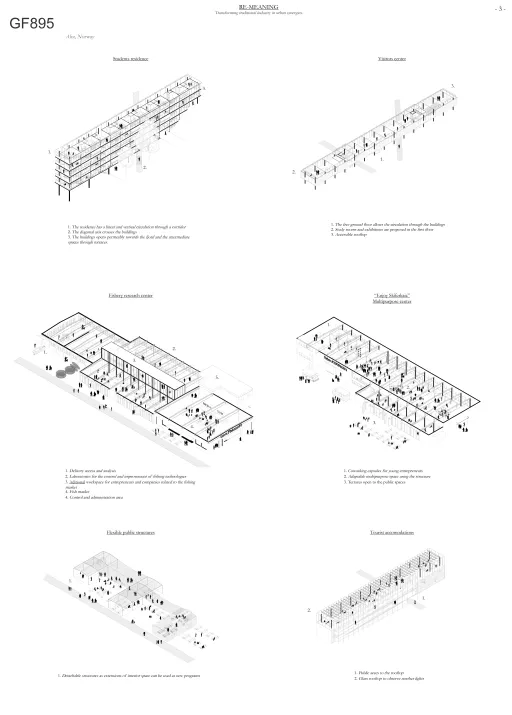Project:
Re-Meaning
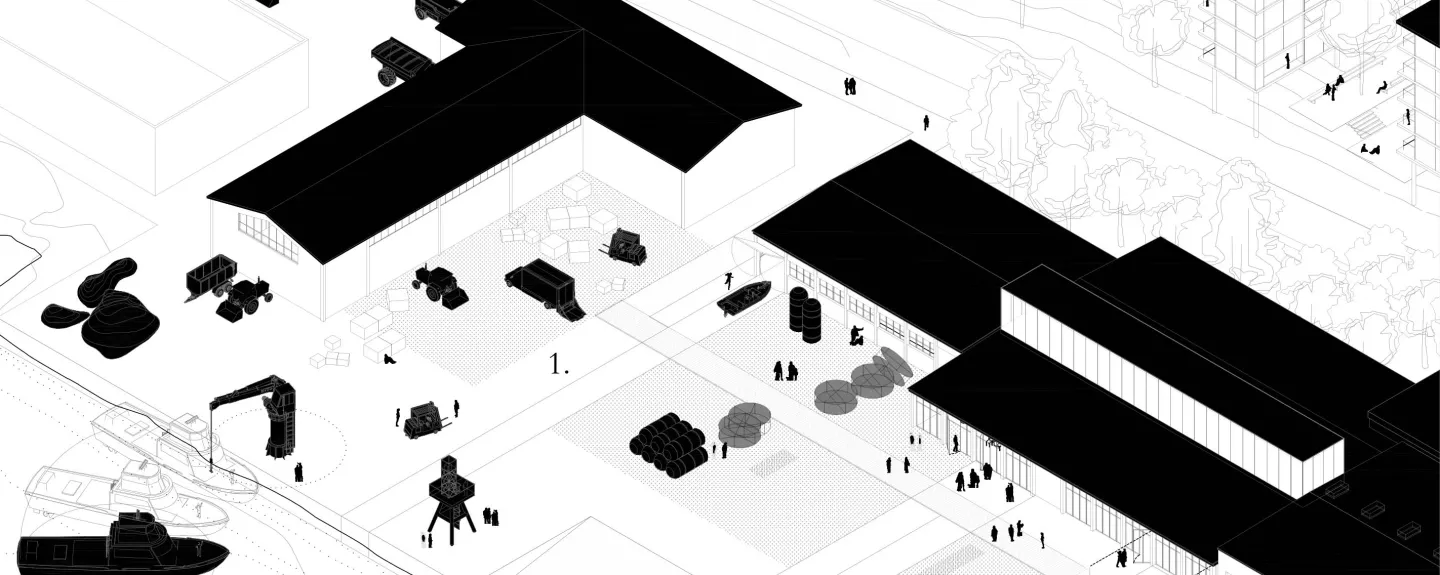
About
-
Skiferkaia
Within the urban context of Alta, Bossekop and Skiferkaia have a relevant position as a gateway, accessing the city of Alta from the south of the country by road or exit, accessing through the airport in Elvebakken. In any case, the potential to become an icon of social and economic activities in the urban context of Alta is considerable due to its easy access from the City, the only 6 kilometers separating the airport and its unique Access to the sea facing the Alta Fjord. These conditions and characteristics inspire the conversion of Skiferkaia and with it, the center of Bossekop, in an experiment of uses and activities, suitable for the economic development of the tourism of the area, research, trade and leisure. Therefore, Re-Meaning proposes an urban system that is capable of creating the formal basis for all these uses and activities, that restructures the dispersed urbanism of the area in a forceful way and modify the coastal front of the city, transforming an industrial urban landscape into a public and productive urban landscape, thus becoming a place of easy access for citizens and with a recognizable urban intervention in the landscape of the city and the fjord.
The seafront transformed in a multifunctional promenade
The clear directionality of the architectural intervention is broken by the appearance of two main paths that cross it, a diagonal establishing a direct connection between the center of Bossekop and the sea front and another horizontal linking the resulting free spaces between buildings. This horizontal walk is part of a landscape intervention that connects the most important points of the coast, modifying them in some points in a substantial way and in others, simply acting as promenade. This line is also essential to understand the connection between the various uses that are proposed in Skiferkaia.
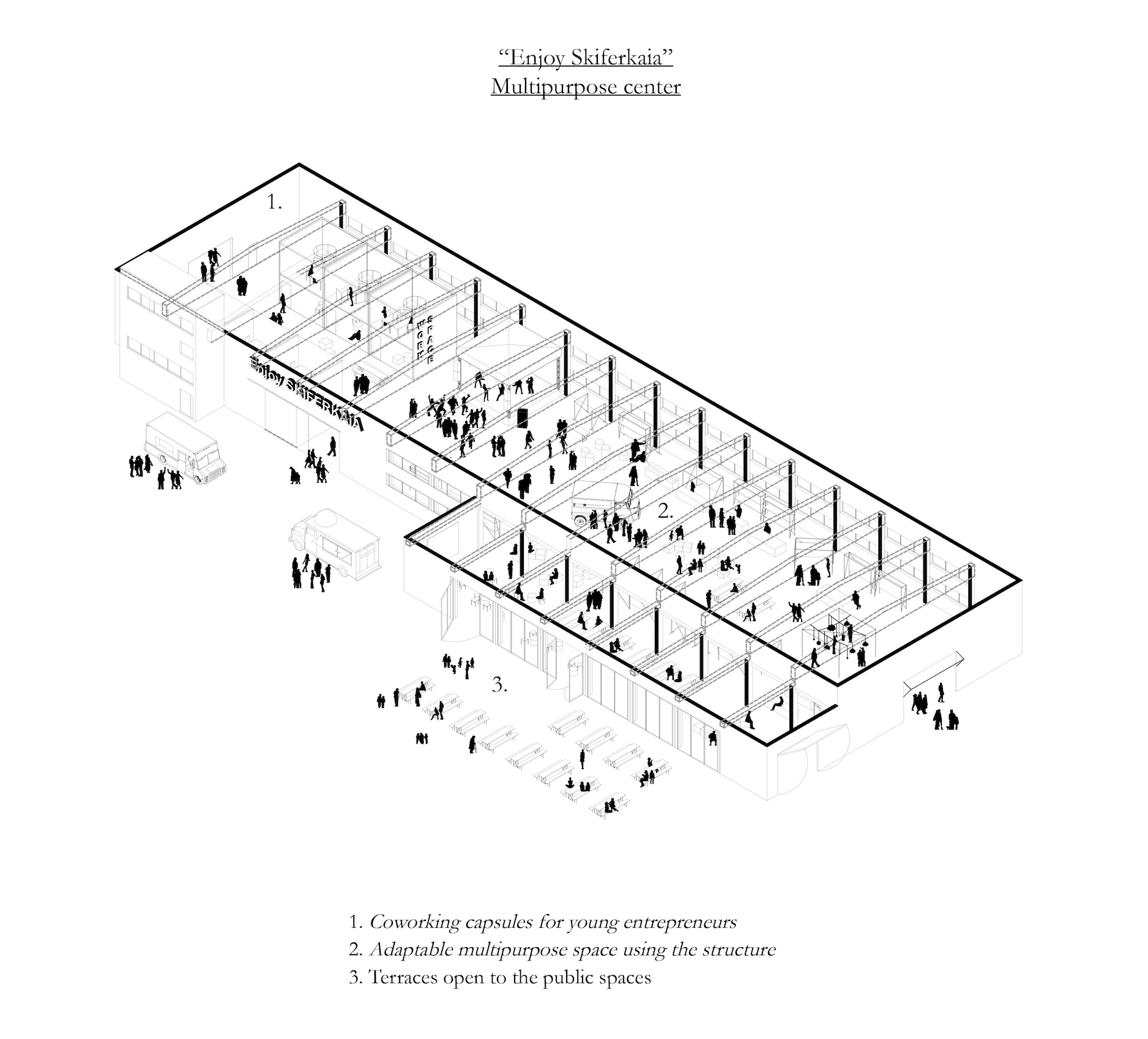
Multipurpose centre How to integrate industrial activities into a public promenade?
Preserving and reinterpreting pre-existing industrial activities is a key factor in making Skiferkaia a productive and multifunctional front. Combining the activities of Felleskjøpet and the agriculture sector with those of the new research center for fishing activities (Strandveien 48) make the eastern part of the Skiferkaia coastline a place that reinterprets and maintains the industrial past. The unloading dock favors the access of ships related to the research center and tectonically modifies the coastal landscape. The formal dialogue between the two buildings is essential for the composition of the public space and its activities.
The new main pedestrian access to Skiferkaia
Two buildings frame the main access to Skiferkaia by establishing a space between them as a corridor that distributes the circulation through horizontal axis and separates the intervention into two large public spaces, one that works as a space of the relationship between the research center and its activities and the points of contact with the sea and another of larger size is intended for social life and organization of events. The two buildings have as program a center of visitors that introduce the Role of Skiferkaia in the social life of Bossekop and Alta and another that functions as a library, work and study spaces related to student residences.
The place to be
The greatest attraction of public life is concentrated in the one which will be the largest public space in Bossekop, open to the sea to the north, and protected by Enjoy Skiferkaia, a multipurpose building that concentrates leisure activities indoor and whose formal flexibility allows these activities inside to flow easily from the inside out and vice versa, being able to accommodate multiplicity of uses such as concerts, fairs, markets, workspaces, exhibitions, etc. Its scale and the diversity of uses of the buildings that surround it, makes this space a flexible and productive place.
The tourism claim
The last set of buildings that forms the great public space of Skiferkaia is destined to the sector of the tourism, proposing thus, a tourist area related to the water sports and the attraction of the northern lights. This space is composed of a first building that acts as a façade to the main square and that serves the tourist accommodation service, another building in vault, formerly intended for the storage of slate, this time as storage of sports equipment and an intermediate space between the above that acts as a relationship area through which the rooftop can be accessed and where camping and sports spaces are proposed.
How to connect Bossekop center with Skiferkaia?
The direct connection between the Bossekop center and Skiferkaia is a strategic issue in the project; This is solved by a sequence of spaces connected through the diagonal axis and traverses the central space organized by the linear typology of student residences. The free ground floor structure creates a complex network of free spaces in the form of terraces. These free spaces structure the accesses to the residences and create diverse platforms along all path, that open towards the landscape.

Students residence -
The transformation strategy in the project Re-Meaning leaves much of the space at Skiferkaia open, while the sloping terrain between Bossekop and Skiferkaia is densily built with student housing. The project propose a diagonal, overlapping connection between the local center and the harbor. The overall plan at Skiferkaia is convincing, but the scale of the student housing and the schematic diagonal connection between Bossekop and Skiferkaia seems insensitive to the landscape situation.
The project proposes to transform the existing buildings at Skiferkaia, and it suggests to add new structures and buildings that together with the existing define the outdoor spaces. The proposed plan with its open, public spaces caters to the seafront. The strategy of transformation leaves room to adapt, and shows a smartness in how it gives the existing buildings a new meaning.
The simplicity of the line drawings throughout the different scales creates on one side a fluent presentation, but the axonometry is difficult to read. The drawings highlight the connection between the cores of Bossekop, City and Elvebakken. Even though the proposal shows a good understanding of the local context in adressing the access to the sea and outdoor activitites, as well as the connection to the airport, the university and the city hall, the jury finds the urban design less convincing than the winning entry.
-
Team Representative: Pablo Menéndez Paunero (ES) – architect
Associates: Ignacio Pérez Anzola (ES), Héctor Termenón López (ES) – architectsHermannstrasse 7, 12049 Berlin (DE)
+49 15751945812 - g33arquitecto@gmail.com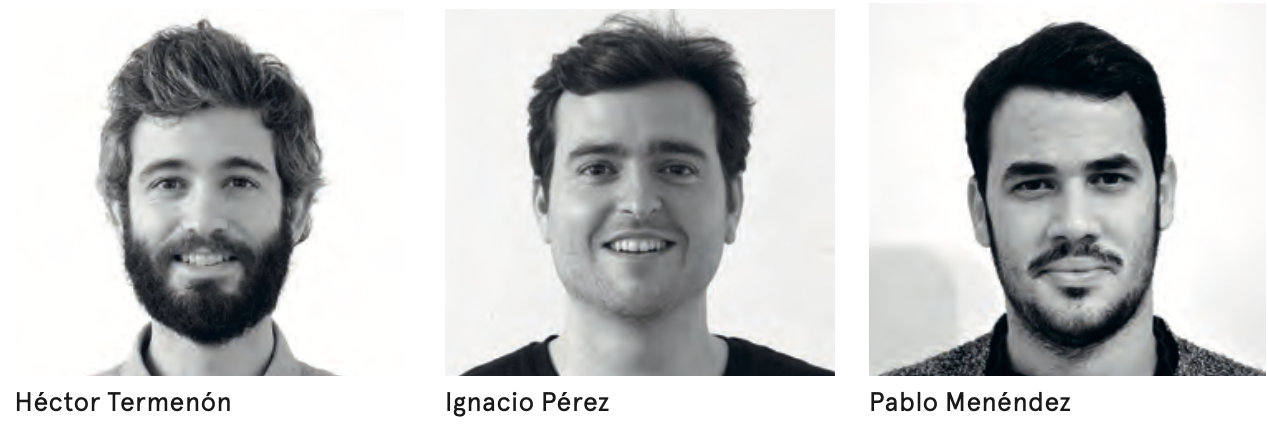
Team
Team interview
1. How did you form the team for the competition?
We met in Berlin as we were working at the same office. During these years we have shared different thoughts and we wanted to do something together, on our own.
2. How do you define the main issue of your project, and how did you answer on this session main topic: the place of productive activities within the city?
Our project is defined by the idea of Re-meaning, taking into account the past and understanding the current urbanism features of the city. The main issue was to create a system that could be adapted to any mixed and open use, giving place to new activities.
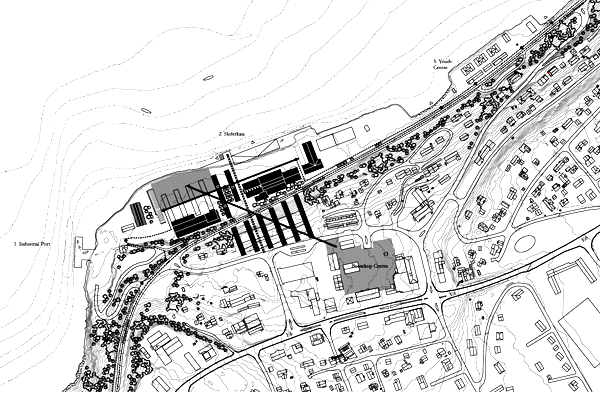
3. How did this issue and the questions raised by the site mutation meet?
Complexity emerged in the first place. After several discussions, we decided to solve the problems working in different layers. Finally, the results is based on free and fluid movements, from the urban connections to the space in between, transferring this idea to the inside buildings.
4. Have you treated this issue previously? What were the reference projects that inspired yours?
During these years we have worked together in several competitions and projects, we are used to work in different topics and scales. The fact that we live in Berlin may help us understand the importance of an open approach to the city. We did not have any real inspired project but the ideas of Andrea Branzi in "Non Stop City" or O.M. Ungers "The City in the City" have had a big impact in our way of understanding the city.
5. Urban-architectural projects like the ones in Europan can only be implemented together with the actors through a negotiated process and in time. How did you consider this issue in your project?
We focused on creating a system that could be strong enough independently. Therefore the project can be built in different phases divided in groups without a fixed order. In terms of adaptability, the system can change according to the needs.
6. Is it the first time you have been awarded a prize at Europan? How could this help you in your professional career?
It is the first time that we have been rewarded by an Europan prize. We are just glad to contribute somehow to develop ideas and to have the opportunity to share them with anyone that is interested in understanding them.
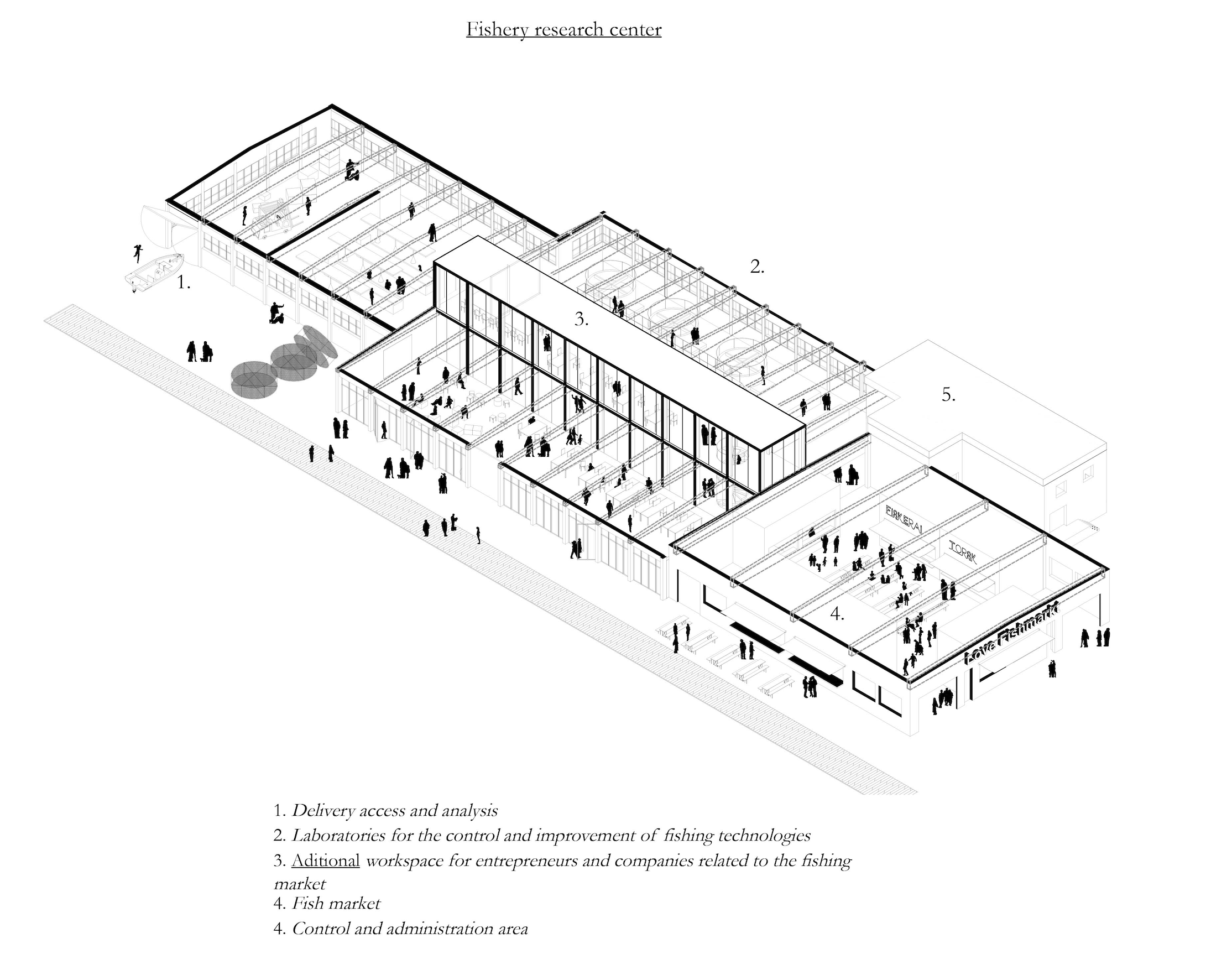
Related projects
-
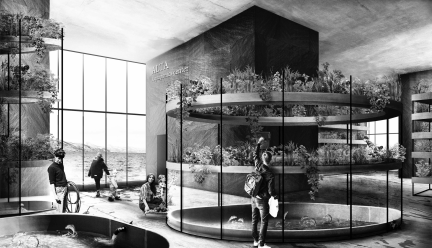
Tanca
We fill the big container with materials by improving industrial and artisanal production, ideas by…
-
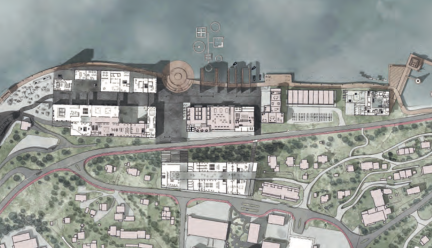
BUSY BOSSE!
This entry examines the importance of human interactions and net- works that comes with a diverse…
-
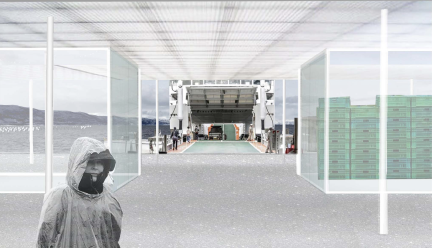
Hydro-Therapy
It’s time to focus back on the sea and find a symbiotic relationship between tourism and maritime…
